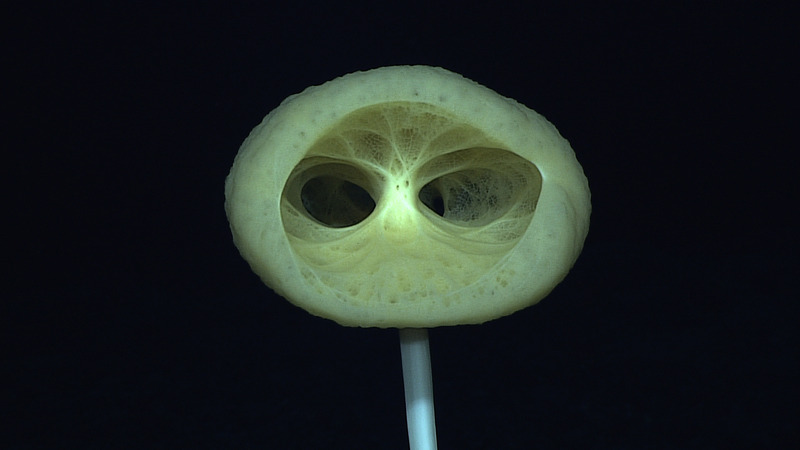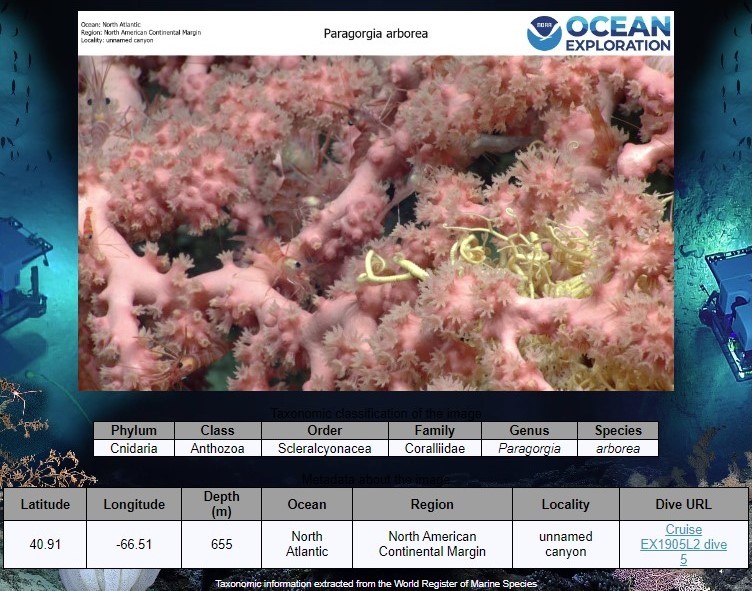Updated Guide Aids Deepwater Animal Identification
NOAA Ocean Exploration’s Benthic Deepwater Animal Identification Guide has become a popular and trusted ocean science community resource and is used (and contributed to) by ocean scientists around the world to help identify animals seen during deep-ocean exploration. With the release of its fourth version in January 2024, the guide is now searchable and includes animals seen in deep waters of the Atlantic along with deepwater animals of the Pacific from earlier versions of the guide.

When it first appeared in the Benthic Deepwater Animal Identification Guide, this sponge was unknown to science. It has since been formally described and given the name Advhena magnifica (meaning “magnificent alien”), because of its resemblance to the alien from the movie E.T.: The Extra-Terrestrial. Its images in the guide have been updated accordingly. Image courtesy of NOAA Ocean Exploration, 2015 Hohonu Moana. Download largest version (jpg, 827Kb)
The guide contains still images of marine animals seen in their native habitat. Since its launch in 2016, this guide has grown from 1,685 images to 6,322 — almost four times as many — and counting.
To aid animal identification, the images are organized by major taxa and are searchable by keyword, depth, and location. Information for each animal, to the extent known, includes taxonomic name (phylum, class, order, family, genus, and species — following the World Register of Marine Species (WoRMS) taxonomic classification); location of observation (latitude and longitude, depth, ocean, region, locality — e.g., seafloor feature); and a link to the landing page of the dive during which it was seen.

There are over 3,000 identified species of deep-sea coral in our ocean, and many of them, like other marine animals, are hard to identify. The Benthic Deepwater Animal Identification Guide aims to ease animal identification during deep-ocean exploration and help us fill gaps in our knowledge. This bubblegum coral (Paragorgia arborea) was seen during Deep Connections 2019: Exploring Atlantic Canyons and Seamounts of the United States and Canada. Download largest version (jpg, 141Kb)
Images were captured from video collected with cameras on remotely operated vehicle (ROV) Deep Discoverer during expeditions on NOAA Ship Okeanos Explorer in the Pacific between 2015 and 2017 as well as a 2019 expedition to the New England Seamounts and along the North American continental margin. Identifications from taxonomic experts were made during live ROV dives as well as after, following close examination of images and collected samples.
The guide has evolved from a pilot project to share exploration results to a valued exploration tool. While its primary audience remains the scientific community, it’s also being used to train artificial intelligence to automate animal detection in underwater video, educate the next generation of ocean scientists, and generate ocean interest among the public.
NOAA Ocean Exploration and its data team at NOAA’s National Centers for Environmental Information will continue to enhance and expand the guide, adding new functionalities and new images, including images from other parts of the global ocean. Identifications will be updated on a periodic basis to correct errors reported by experts and reflect taxonomic revisions and new descriptions accepted in WoRMS.
Follow expeditions on NOAA Ship Okeanos Explorer to see these animals in real time — and then use the guide, available on the NOAA Ocean Exploration website, to help identify them.
Published January 31, 2024